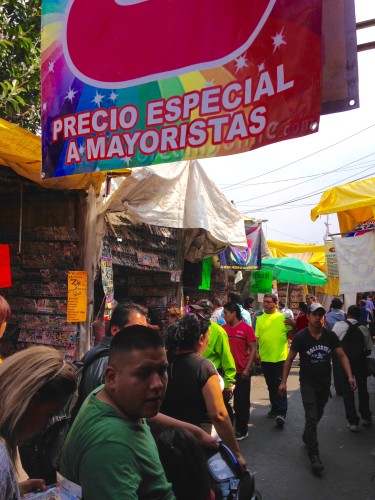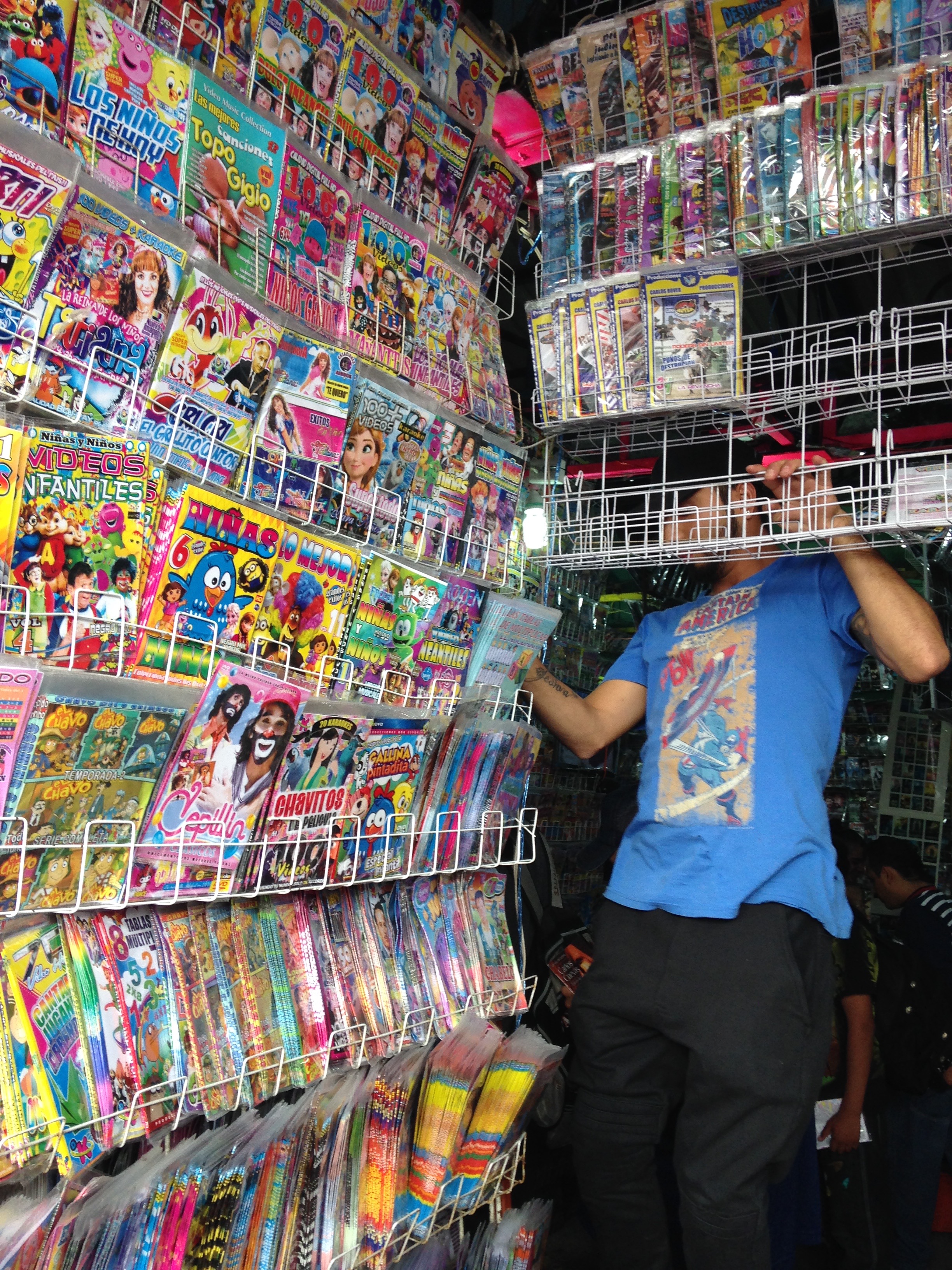My last full day in Mexico City in January 2012, I still hadn’t gone to Tepito’s street market. In my readings on the so-called piracy of music and media, Tepito was the stuff of legend.
In the 1920s, Mexico’s secondhand market, “El Baratillo,” moved to Tepito and became known as the “thieves’ market” because of the questionable origins of some of these goods. By the ’80s, Tepito was the center of illegally imported contraband. Today Tepito with its roughly 10,000 stands is a wholesale production center and market of “pirated” media in Mexico. The stalls stretch for miles. Contrary to the MPAA’s sponsored “research” linking media piracy in Tepito to drug cartels and terrorism, the production and sale of “pirated†music and media are actually run by small, family businesses.
And so we boarded the subway, that subterranean circus and moving market. A day earlier a shirtless man chanted half a prayer to the street before somersaulting forwards and backwards over shards of broken glass laid out in his t-shirt. His back was scabbed and a little raw, I imagined, like that of a self-flagellant on Good Friday. But, he did this for coins. That day, however, we shared metro cars with pen sellers and a dread-locked young woman who recited Charles Bukowski in Spanish, then left the train without asking for money.
The Tepito stop opened up straight into the market place. Old-school Colombian cumbia and Hector Lavoe played from the nearest stand. “Do you have any tribal?†I asked the tough-looking middle-aged woman with buzzed hair dyed platinum. She pointed me in the right direction and told me that she sold only “classics.†I bought three burned albums for 5 pesos each. We made our way through the street jammed with stands selling knock-off clothing, cheap, plastic toys, cartons of Chinese cigarettes.

We reached the alleyway where the CD and DVD stands began. I stopped at a couple stands and bought five MP3 CDs from each of banda, tribal, cumbia sonidera, narco-corridos. The CDs from the first stand had MP3 MEGATRON stamped on them. At the second booth each CD was labeled “Producciones Shark 2012” and marked with the promise that “The Quality is Here, You Decide.” It was only January 5th but the all the CDs announced Cumbias 2012 and “Lo Mejor de 2012.” Labels had a jingle-like poetry, “La Marca Que Prefiere La Industria de la Pirateria,” The Brand That the Piracy Industry Prefers, “Hecho En Tepito Para Los Tepiteños,” Made in Tepito for the Tepitans, and “Somos Los Meros Padrinos De La Industria De La Pirateria,” We Are the Best Godfathers of the Piracy Industry. Several tracks were also listed as Shark DJ productions or remixes. At 3.50 pesos (about 30 cents), the CDs were cheaper than some blank CD-Rs I’d seen for sale on the street and in the metro. Increasingly, the blank CDs are bought from Chinese vendors rather than on trips to Los Angeles.

We continued through the labyrinth of stalls sat down at an outdoor table and ordered Micheladas next to a table of men playing cards. My Chilean friend, a reporter, mentioned that she thought La Sonora, the witchcraft market was somewhere nearby. When I walked inside to pay, a man, who said he was a born Tepiteño, asked me where I was from and if I had found everything I was looking for. I asked about La Sonora. “The witch market is close, but you shouldn’t go today,” he said, “Tomorrow’s Three Kings, so you’ll just find people selling kids’ toys. Visit there in two days, then it will be back to normal.” Black magic as usual.
When I returned to Tepito this spring, I asked vendors if they were selling tribal. Everyone kept referring me to someone else who might have it. The fad, apparently, had faded. Cumbia still ruled the market. Sonidero compilations–some mixed live by the DJs of soundsystems like Sonido Super Dengue–reflected the mobility of the music, with songs from across the cumbia cosmos, crossing time and space. All songs on the Sonido Super Dengue compilation, however, were credited under the “pirate brand,” Lobo DJ. Still I recognized Los Mirlos’ (Peru) “Cumbia de los Pajaritos,” “Cumbia con Arpa” from Hugo Blanco (Venezuela), “Sal y Agua” by Lisandro Meza (Colombia), and “Cumbia de los Toquesitos” from Eduardo Zurita (Ecuador), and several songs from Grupo Kual (Mexico).
https://www.youtube.com/watch?v=2rTd087NEQs
When I return to Tepito, I’ll have to come for the barrio’s anniversary party or at least for a vibrant sonidero session.
Further Reading & Listening
José Carlos Aguiar 2013 “Smugglers, Fayuqueros, Piratas: Transitory Commodities and Illegality in the Trade of Pirated CDs in Mexico” PoLAR: Political and Legal Anthropology Review 36(2): 249-265.
Daniel Hernandez 2010 Domus Mixtape #1: The Sound of Mexico DF (Curated by Daniel Perlin).
Joe Karaginis 2011 Media Piracy in Emerging Economies. Social Science Research Council.
